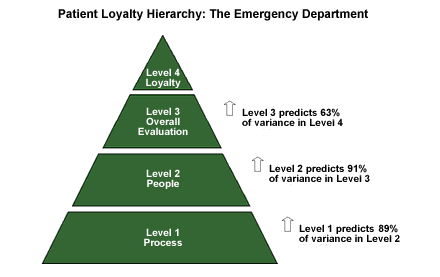What drives patient satisfaction and loyalty in the emergency department? Gallup has found the structural relationships that determine satisfaction and loyalty in the emergency department to be very similar to those in the inpatient and outpatient operating environments.

Process variables such as speed and efficiency are at the foundation of the hierarchy, but they often represent "dissatisfiers" -- expectations that are largely taken for granted. They produce dissatisfied patients if they aren't met, but their implementation isn't what makes the hospital stand out in patients' minds. Still, a strong performance with regard to process variables is a prerequisite to allowing people -- hospital staff members -- to excel. People-related variables are those that allow the hospital to create a strong positive impression of the emergency department.
ED Performance on Process
In April 2002, the American Hospital Association released the results of its survey of emergency department and hospital capacity, conducted by The Lewin Group. The survey included 1,501 hospitals with ED services (36% of all hospitals with EDs) for November 2001. Among the key findings:
- ED volume grew 5% from 2000 to 2001.
- 62% of hospitals surveyed report operating "at" or "over" capacity.
- One-third of hospitals (33%) experienced "ED diversion" (times when their EDs could no longer accept all or specific types of patients by ambulance). Lack of available critical care beds was the No. 1 reason cited for ED diversion.
- Capacity constraints translate into longer wait times for treatment, longer stays in the ED, and longer wait times for admission to acute care beds.
ED Satisfaction
Clearly, the nation's emergency departments are experiencing a crisis in the speed and efficiency base of Gallup's loyalty model -- but what is the result? Last week's Tuesday Briefing reported that inpatient satisfaction scores are lower among patients admitted through the ED than among those admitted elsewhere. (See The ED: Doorway to Dissatisfaction?) However, according to Gallup's aggregated healthcare database, there has been no recent dramatic decline in satisfaction scores for EDs themselves: the mean scores for 1999, 2000 and 2001 are 3.32, 3.30 and 3.29, respectively.
Is There Really a Crisis?
While satisfaction scores for emergency departments have historically been, and continue to be, low relative to those for other healthcare services, they don't appear to be dropping dramatically. One possibility suggested by the data is that the true crisis is not yet among the treated-and-released patient population, but among the growing "urgent" population who are diverted from the ED and admitted to the hospital -- and therefore rate inpatient rather than emergency services.
One approach that the nation's hospitals should consider is to examine the ED-inpatient interface. With so many patients moving from one department to the other, hospital administrators can no longer afford to view them as separate, and only moderately related functions.